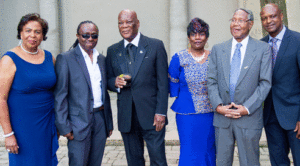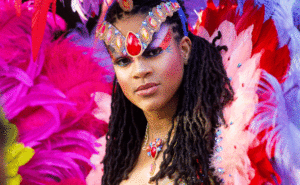The Peeks Toronto Caribbean Carnival Ball 2017

The night was set to Caribbean culture indeed! Pomp, Pageantry, Music, Dance, Caribbean humour and a brief flare of temper from a man burned by Mark Trinidad’s fun-filled Roast, sums up the Carnival Ball 2017 on Saturday.
The Ball at the Liberty Grand, Exhibition Place marked the celebration of the 50th anniversary of the Toronto Caribbean Carnival. It brought together lovers, practitioners, curators, promoters and guardians of Caribbean culture in celebration of the heritage of the Caribbean in Toronto. Three of the founders and several outstanding contributors to the development of the festival and its key cultural art forms were recognized. They were:
- Joseph Liverpool (Founder), the first Chairman of the inaugural Caribbean Cultural Committee (CCC);
- Romain Pitt (Founder), retired judge;
- Maurice Bygrave, (Founder);
- Alpha King, one of the pioneers of the Festival;
- Whitfield Belasco, longtime Carnival artists and bandleader;
- Selwyn Gomes who has taught pan for over six decades and have helped to established one of Toronto’s best Youth Pan programs;
- Leslie Forbes for his contribution to the Caribana Arts Group, among other significant service for preserving Caribbean Heritage in Toronto;
- Grammy award-winning Ossie Gurley for his contribution to the music;
- Beverley Salmon, for service to the CCC and her role in securing a building at just $1 per year;
- Colin Benjamin for his service to the (CCC) and the Festival Management Committee (FMC);
- Louis Saldenah for his role in raising funds for the bands annually; and
- Marline Price-Jones for her role in costume design.
One of the founders, Dr. Bygrave, recalled that the event was the first of its kind since 2008 and he was disappointed that the event was not attended by any provincial or local level government representative.
But after fifty-years have we got Carnival right in Toronto? Not yet was the response of Dr. Bygrave. He believes we need to ensure that all the “people of Caribbean descent are involved in the Festival”. He emphasized the need to revisit the intended purpose of CARIBANA— “that is to showcase, preserve and promote Caribbean culture”. The Festival was meant to go beyond introducing Canadians to the culture but to whet their appetites for the culture and to drive their desires to “travel to each island,“he said.
King agrees with Dr. Bygrave that we have not yet gotten Carnival right in Toronto. He lamented that the Caribbean Community is yet to understand the value of CARIBANA including the $800 million that the Festival brings to the city annually. Dr. Bygrave also wishes to see the Caribbean Community benefit more from the takings from CARIBANA.
CARIBANA should not be focused on just Mas` but also on the other aspects of culture such as storytelling as in the early days when Paul Keens-Douglas, Dr. Louise Bennett and others were involved, steel pan and all other related art forms.
Both Mr. King and Dr. Bygrave believe the Jubilee year and its celebration would have had a greater impact if forgiveness and unity had been a part of the process. Dr. Bygrave thought this was especially relevant in the relationship between the FMC and the Caribana Arts Group (CAG).
Mr. King also believes individuals should be paid for their contribution to the Festival instead of simply serving as volunteers. He warns the Caribbean community to get rid of internal divisiveness and “racism” and to “pursue inclusiveness” to benefit from and retain CARIBANA. He cautions that the Government of Canada will not sit back and watch eight-hundred million slip away if the Caribbean Community fails to step up to the tasks of delivering the event but that they will simply take control of the Festival.
The name CARIBANA is deeply engrained, says Dr. Bygrave, “It is not a slip of the tongue. Let the excellence that manifested at the Ball be our catalyst for revisiting the original images and purpose of CARIBANA.




